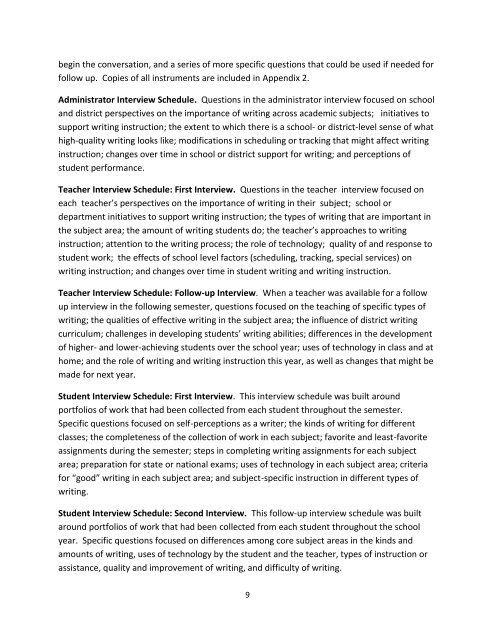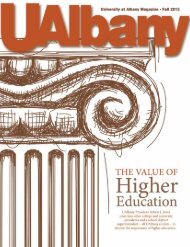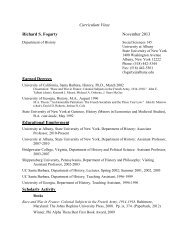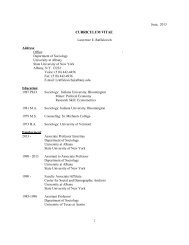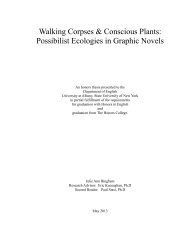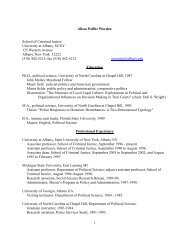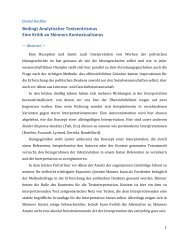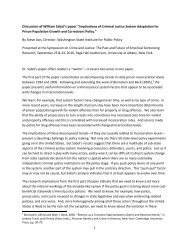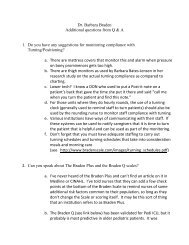The National Study of Writing Instruction - University at Albany
The National Study of Writing Instruction - University at Albany
The National Study of Writing Instruction - University at Albany
You also want an ePaper? Increase the reach of your titles
YUMPU automatically turns print PDFs into web optimized ePapers that Google loves.
egin the convers<strong>at</strong>ion, and a series <strong>of</strong> more specific questions th<strong>at</strong> could be used if needed for<br />
follow up. Copies <strong>of</strong> all instruments are included in Appendix 2.<br />
Administr<strong>at</strong>or Interview Schedule. Questions in the administr<strong>at</strong>or interview focused on school<br />
and district perspectives on the importance <strong>of</strong> writing across academic subjects; initi<strong>at</strong>ives to<br />
support writing instruction; the extent to which there is a school- or district-level sense <strong>of</strong> wh<strong>at</strong><br />
high-quality writing looks like; modific<strong>at</strong>ions in scheduling or tracking th<strong>at</strong> might affect writing<br />
instruction; changes over time in school or district support for writing; and perceptions <strong>of</strong><br />
student performance.<br />
Teacher Interview Schedule: First Interview. Questions in the teacher interview focused on<br />
each teacher’s perspectives on the importance <strong>of</strong> writing in their subject; school or<br />
department initi<strong>at</strong>ives to support writing instruction; the types <strong>of</strong> writing th<strong>at</strong> are important in<br />
the subject area; the amount <strong>of</strong> writing students do; the teacher’s approaches to writing<br />
instruction; <strong>at</strong>tention to the writing process; the role <strong>of</strong> technology; quality <strong>of</strong> and response to<br />
student work; the effects <strong>of</strong> school level factors (scheduling, tracking, special services) on<br />
writing instruction; and changes over time in student writing and writing instruction.<br />
Teacher Interview Schedule: Follow-up Interview. When a teacher was available for a follow<br />
up interview in the following semester, questions focused on the teaching <strong>of</strong> specific types <strong>of</strong><br />
writing; the qualities <strong>of</strong> effective writing in the subject area; the influence <strong>of</strong> district writing<br />
curriculum; challenges in developing students’ writing abilities; differences in the development<br />
<strong>of</strong> higher- and lower-achieving students over the school year; uses <strong>of</strong> technology in class and <strong>at</strong><br />
home; and the role <strong>of</strong> writing and writing instruction this year, as well as changes th<strong>at</strong> might be<br />
made for next year.<br />
Student Interview Schedule: First Interview. This interview schedule was built around<br />
portfolios <strong>of</strong> work th<strong>at</strong> had been collected from each student throughout the semester.<br />
Specific questions focused on self-perceptions as a writer; the kinds <strong>of</strong> writing for different<br />
classes; the completeness <strong>of</strong> the collection <strong>of</strong> work in each subject; favorite and least-favorite<br />
assignments during the semester; steps in completing writing assignments for each subject<br />
area; prepar<strong>at</strong>ion for st<strong>at</strong>e or n<strong>at</strong>ional exams; uses <strong>of</strong> technology in each subject area; criteria<br />
for “good” writing in each subject area; and subject-specific instruction in different types <strong>of</strong><br />
writing.<br />
Student Interview Schedule: Second Interview. This follow-up interview schedule was built<br />
around portfolios <strong>of</strong> work th<strong>at</strong> had been collected from each student throughout the school<br />
year. Specific questions focused on differences among core subject areas in the kinds and<br />
amounts <strong>of</strong> writing, uses <strong>of</strong> technology by the student and the teacher, types <strong>of</strong> instruction or<br />
assistance, quality and improvement <strong>of</strong> writing, and difficulty <strong>of</strong> writing.<br />
9


